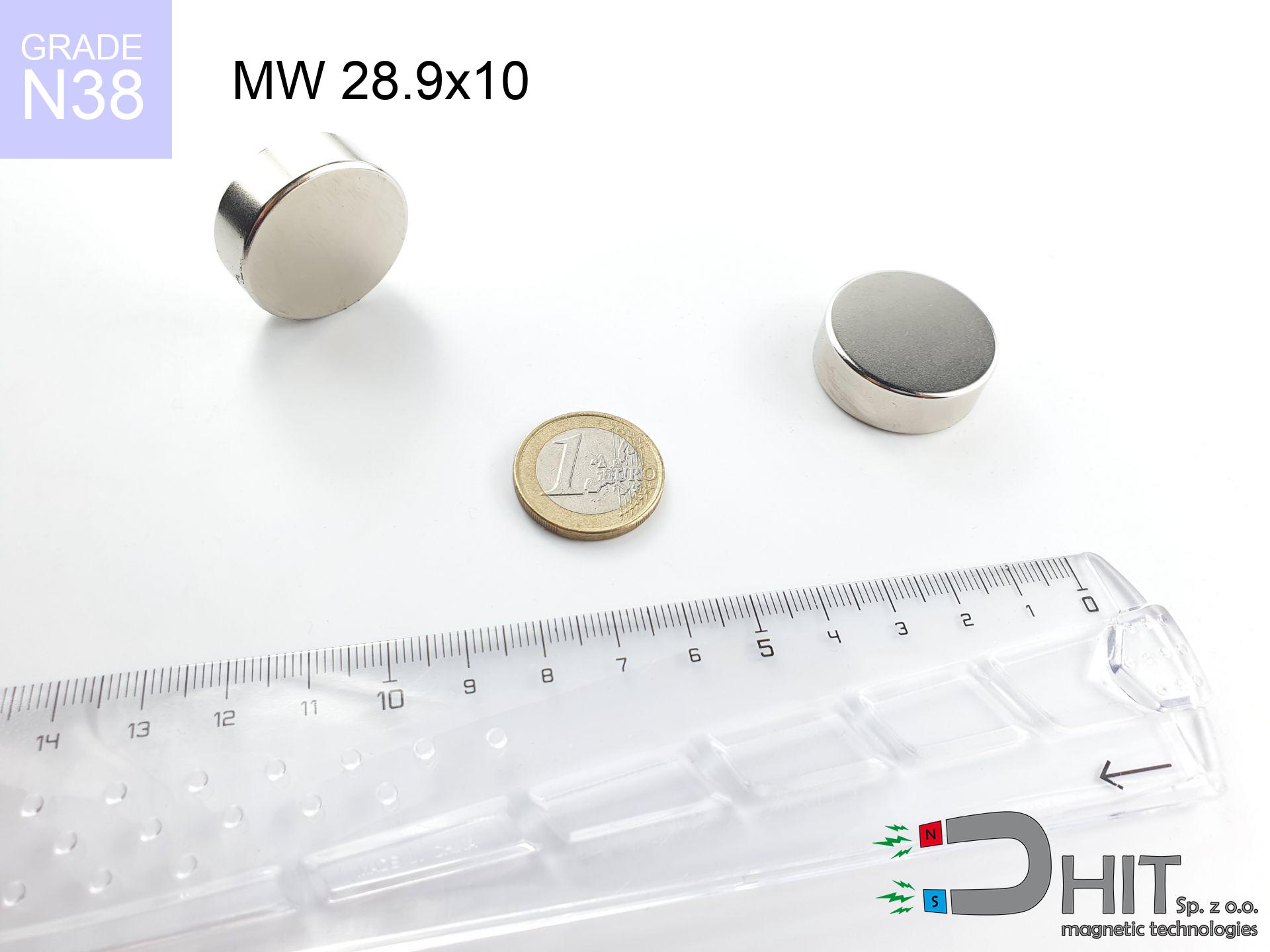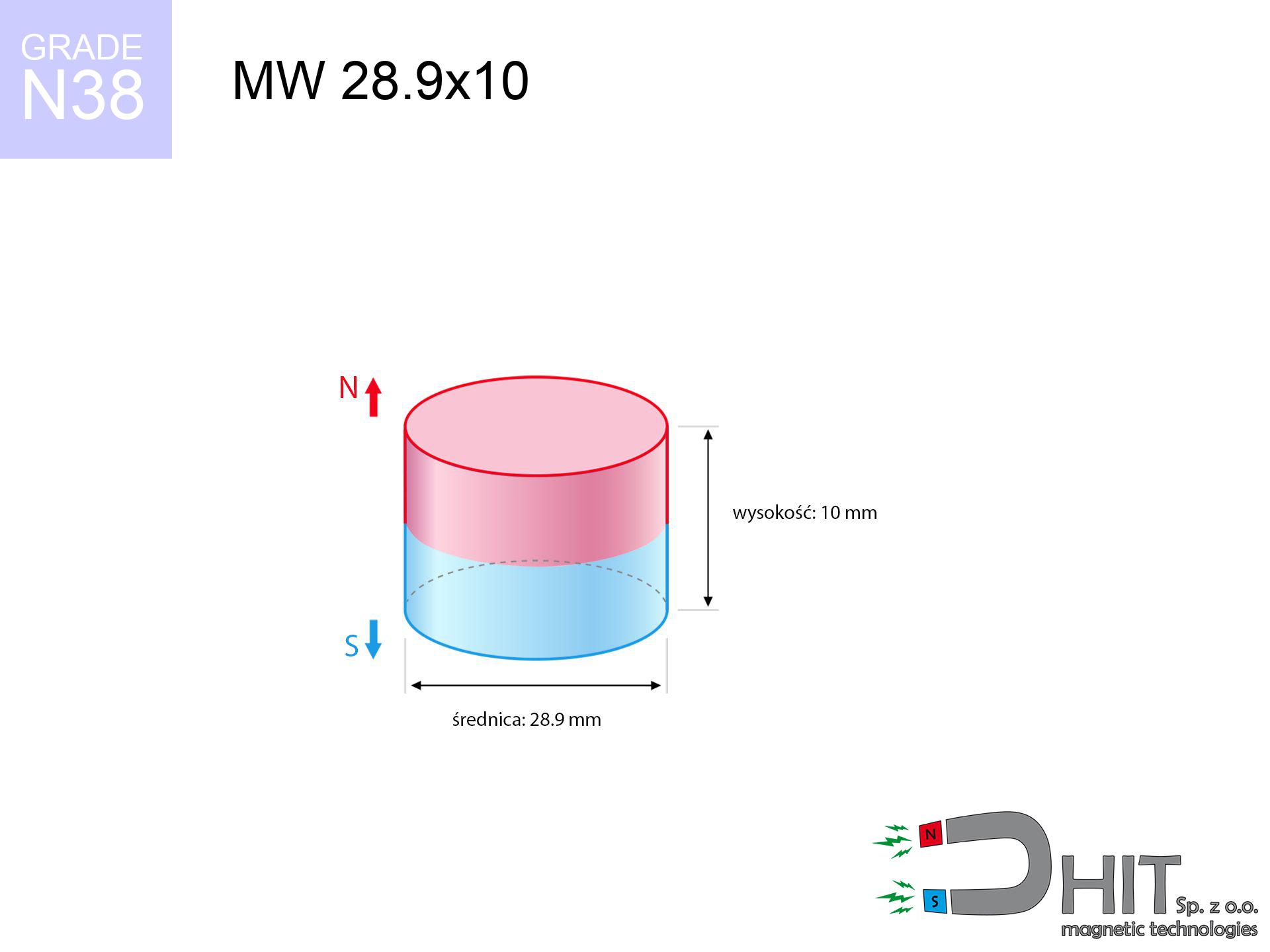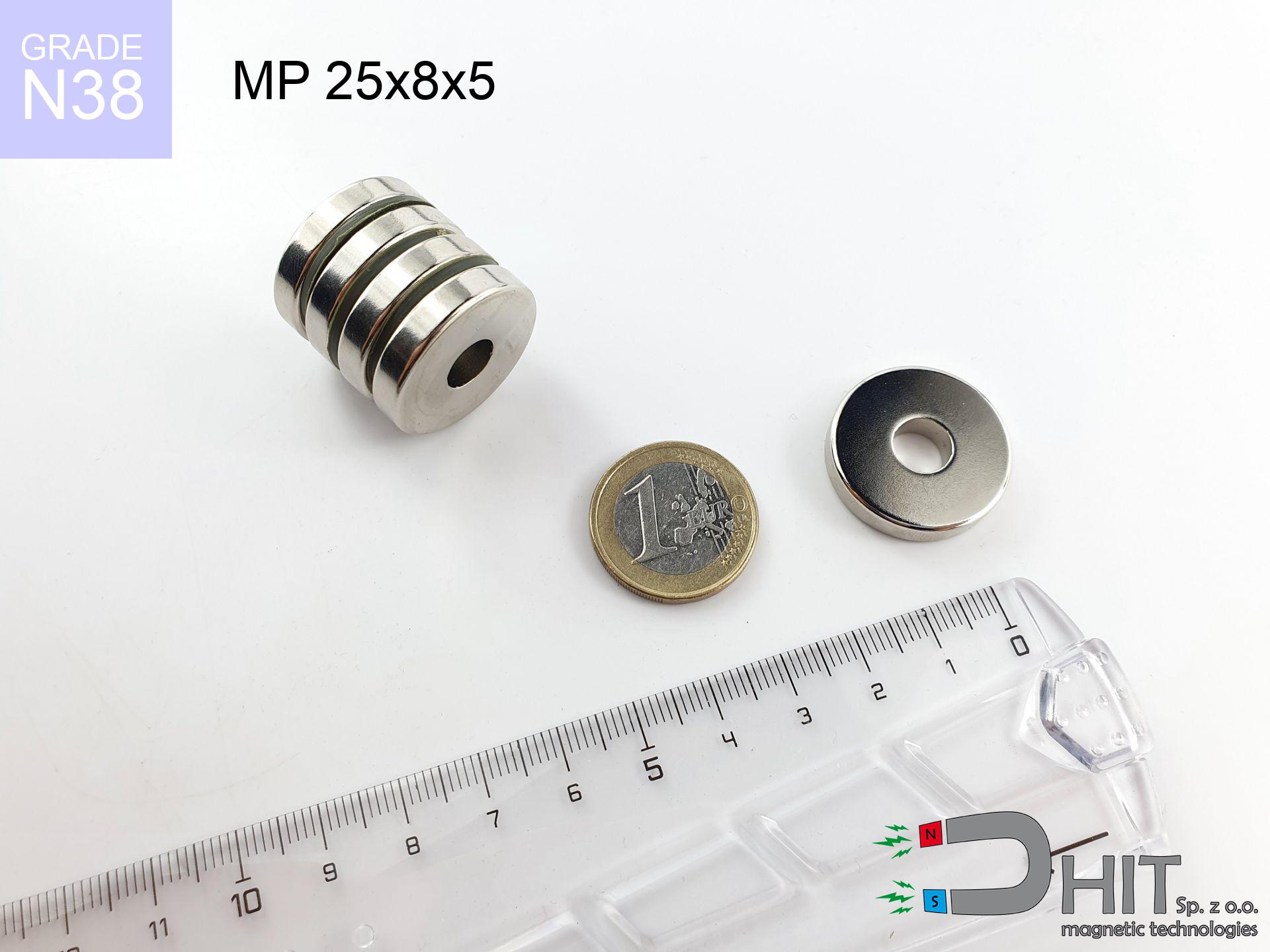MW 28.9x10 / N38 - cylindrical magnet
cylindrical magnet
Catalog no 010051
GTIN/EAN: 5906301810506
Diameter Ø
28.9 mm [±0,1 mm]
Height
10 mm [±0,1 mm]
Weight
49.2 g
Magnetization Direction
→ diametrical
Load capacity
20.74 kg / 203.46 N
Magnetic Induction
352.70 mT / 3527 Gs
Coating
[NiCuNi] Nickel
23.99 ZŁ with VAT / pcs + price for transport
19.50 ZŁ net + 23% VAT / pcs
bulk discounts:
Need more?
Pick up the phone and ask
+48 888 99 98 98
otherwise drop us a message through
request form
the contact form page.
Specifications and shape of a magnet can be verified on our
force calculator.
Same-day processing for orders placed before 14:00.
Technical data - MW 28.9x10 / N38 - cylindrical magnet
Specification / characteristics - MW 28.9x10 / N38 - cylindrical magnet
| properties | values |
|---|---|
| Cat. no. | 010051 |
| GTIN/EAN | 5906301810506 |
| Production/Distribution | Dhit sp. z o.o. |
| Country of origin | Poland / China / Germany |
| Customs code | 85059029 |
| Diameter Ø | 28.9 mm [±0,1 mm] |
| Height | 10 mm [±0,1 mm] |
| Weight | 49.2 g |
| Magnetization Direction | → diametrical |
| Load capacity ~ ? | 20.74 kg / 203.46 N |
| Magnetic Induction ~ ? | 352.70 mT / 3527 Gs |
| Coating | [NiCuNi] Nickel |
| Manufacturing Tolerance | ±0.1 mm |
Magnetic properties of material N38
| properties | values | units |
|---|---|---|
| remenance Br [min. - max.] ? | 12.2-12.6 | kGs |
| remenance Br [min. - max.] ? | 1220-1260 | mT |
| coercivity bHc ? | 10.8-11.5 | kOe |
| coercivity bHc ? | 860-915 | kA/m |
| actual internal force iHc | ≥ 12 | kOe |
| actual internal force iHc | ≥ 955 | kA/m |
| energy density [min. - max.] ? | 36-38 | BH max MGOe |
| energy density [min. - max.] ? | 287-303 | BH max KJ/m |
| max. temperature ? | ≤ 80 | °C |
Physical properties of sintered neodymium magnets Nd2Fe14B at 20°C
| properties | values | units |
|---|---|---|
| Vickers hardness | ≥550 | Hv |
| Density | ≥7.4 | g/cm3 |
| Curie Temperature TC | 312 - 380 | °C |
| Curie Temperature TF | 593 - 716 | °F |
| Specific resistance | 150 | μΩ⋅cm |
| Bending strength | 250 | MPa |
| Compressive strength | 1000~1100 | MPa |
| Thermal expansion parallel (∥) to orientation (M) | (3-4) x 10-6 | °C-1 |
| Thermal expansion perpendicular (⊥) to orientation (M) | -(1-3) x 10-6 | °C-1 |
| Young's modulus | 1.7 x 104 | kg/mm² |
Physical simulation of the assembly - technical parameters
These values represent the result of a physical calculation. Results were calculated on algorithms for the class Nd2Fe14B. Real-world performance may differ from theoretical values. Treat these data as a preliminary roadmap when designing systems.
Table 1: Static force (pull vs gap) - interaction chart
MW 28.9x10 / N38
| Distance (mm) | Induction (Gauss) / mT | Pull Force (kg/lbs/g/N) | Risk Status |
|---|---|---|---|
| 0 mm |
3526 Gs
352.6 mT
|
20.74 kg / 45.72 lbs
20740.0 g / 203.5 N
|
crushing |
| 1 mm |
3327 Gs
332.7 mT
|
18.47 kg / 40.71 lbs
18466.2 g / 181.2 N
|
crushing |
| 2 mm |
3111 Gs
311.1 mT
|
16.14 kg / 35.59 lbs
16142.6 g / 158.4 N
|
crushing |
| 3 mm |
2886 Gs
288.6 mT
|
13.90 kg / 30.63 lbs
13895.8 g / 136.3 N
|
crushing |
| 5 mm |
2438 Gs
243.8 mT
|
9.91 kg / 21.85 lbs
9912.0 g / 97.2 N
|
strong |
| 10 mm |
1497 Gs
149.7 mT
|
3.74 kg / 8.24 lbs
3739.6 g / 36.7 N
|
strong |
| 15 mm |
903 Gs
90.3 mT
|
1.36 kg / 3.00 lbs
1359.1 g / 13.3 N
|
low risk |
| 20 mm |
560 Gs
56.0 mT
|
0.52 kg / 1.15 lbs
523.5 g / 5.1 N
|
low risk |
| 30 mm |
245 Gs
24.5 mT
|
0.10 kg / 0.22 lbs
100.4 g / 1.0 N
|
low risk |
| 50 mm |
71 Gs
7.1 mT
|
0.01 kg / 0.02 lbs
8.5 g / 0.1 N
|
low risk |
Table 2: Vertical capacity (wall)
MW 28.9x10 / N38
| Distance (mm) | Friction coefficient | Pull Force (kg/lbs/g/N) |
|---|---|---|
| 0 mm | Stal (~0.2) |
4.15 kg / 9.14 lbs
4148.0 g / 40.7 N
|
| 1 mm | Stal (~0.2) |
3.69 kg / 8.14 lbs
3694.0 g / 36.2 N
|
| 2 mm | Stal (~0.2) |
3.23 kg / 7.12 lbs
3228.0 g / 31.7 N
|
| 3 mm | Stal (~0.2) |
2.78 kg / 6.13 lbs
2780.0 g / 27.3 N
|
| 5 mm | Stal (~0.2) |
1.98 kg / 4.37 lbs
1982.0 g / 19.4 N
|
| 10 mm | Stal (~0.2) |
0.75 kg / 1.65 lbs
748.0 g / 7.3 N
|
| 15 mm | Stal (~0.2) |
0.27 kg / 0.60 lbs
272.0 g / 2.7 N
|
| 20 mm | Stal (~0.2) |
0.10 kg / 0.23 lbs
104.0 g / 1.0 N
|
| 30 mm | Stal (~0.2) |
0.02 kg / 0.04 lbs
20.0 g / 0.2 N
|
| 50 mm | Stal (~0.2) |
0.00 kg / 0.00 lbs
2.0 g / 0.0 N
|
Table 3: Wall mounting (shearing) - behavior on slippery surfaces
MW 28.9x10 / N38
| Surface type | Friction coefficient / % Mocy | Max load (kg/lbs/g/N) |
|---|---|---|
| Raw steel |
µ = 0.3
30% Nominalnej Siły
|
6.22 kg / 13.72 lbs
6222.0 g / 61.0 N
|
| Painted steel (standard) |
µ = 0.2
20% Nominalnej Siły
|
4.15 kg / 9.14 lbs
4148.0 g / 40.7 N
|
| Oily/slippery steel |
µ = 0.1
10% Nominalnej Siły
|
2.07 kg / 4.57 lbs
2074.0 g / 20.3 N
|
| Magnet with anti-slip rubber |
µ = 0.5
50% Nominalnej Siły
|
10.37 kg / 22.86 lbs
10370.0 g / 101.7 N
|
Table 4: Steel thickness (substrate influence) - sheet metal selection
MW 28.9x10 / N38
| Steel thickness (mm) | % power | Real pull force (kg/lbs/g/N) |
|---|---|---|
| 0.5 mm |
|
1.04 kg / 2.29 lbs
1037.0 g / 10.2 N
|
| 1 mm |
|
2.59 kg / 5.72 lbs
2592.5 g / 25.4 N
|
| 2 mm |
|
5.19 kg / 11.43 lbs
5185.0 g / 50.9 N
|
| 3 mm |
|
7.78 kg / 17.15 lbs
7777.5 g / 76.3 N
|
| 5 mm |
|
12.96 kg / 28.58 lbs
12962.5 g / 127.2 N
|
| 10 mm |
|
20.74 kg / 45.72 lbs
20740.0 g / 203.5 N
|
| 11 mm |
|
20.74 kg / 45.72 lbs
20740.0 g / 203.5 N
|
| 12 mm |
|
20.74 kg / 45.72 lbs
20740.0 g / 203.5 N
|
Table 5: Working in heat (stability) - resistance threshold
MW 28.9x10 / N38
| Ambient temp. (°C) | Power loss | Remaining pull (kg/lbs/g/N) | Status |
|---|---|---|---|
| 20 °C | 0.0% |
20.74 kg / 45.72 lbs
20740.0 g / 203.5 N
|
OK |
| 40 °C | -2.2% |
20.28 kg / 44.72 lbs
20283.7 g / 199.0 N
|
OK |
| 60 °C | -4.4% |
19.83 kg / 43.71 lbs
19827.4 g / 194.5 N
|
|
| 80 °C | -6.6% |
19.37 kg / 42.71 lbs
19371.2 g / 190.0 N
|
|
| 100 °C | -28.8% |
14.77 kg / 32.56 lbs
14766.9 g / 144.9 N
|
Table 6: Two magnets (repulsion) - field collision
MW 28.9x10 / N38
| Gap (mm) | Attraction (kg/lbs) (N-S) | Shear Force (kg/lbs/g/N) | Repulsion (kg/lbs) (N-N) |
|---|---|---|---|
| 0 mm |
50.29 kg / 110.86 lbs
5 022 Gs
|
7.54 kg / 16.63 lbs
7543 g / 74.0 N
|
N/A |
| 1 mm |
47.58 kg / 104.90 lbs
6 860 Gs
|
7.14 kg / 15.74 lbs
7138 g / 70.0 N
|
42.83 kg / 94.41 lbs
~0 Gs
|
| 2 mm |
44.77 kg / 98.71 lbs
6 655 Gs
|
6.72 kg / 14.81 lbs
6716 g / 65.9 N
|
40.30 kg / 88.84 lbs
~0 Gs
|
| 3 mm |
41.95 kg / 92.48 lbs
6 441 Gs
|
6.29 kg / 13.87 lbs
6292 g / 61.7 N
|
37.75 kg / 83.23 lbs
~0 Gs
|
| 5 mm |
36.38 kg / 80.20 lbs
5 999 Gs
|
5.46 kg / 12.03 lbs
5457 g / 53.5 N
|
32.74 kg / 72.18 lbs
~0 Gs
|
| 10 mm |
24.03 kg / 52.98 lbs
4 876 Gs
|
3.60 kg / 7.95 lbs
3605 g / 35.4 N
|
21.63 kg / 47.69 lbs
~0 Gs
|
| 20 mm |
9.07 kg / 19.99 lbs
2 995 Gs
|
1.36 kg / 3.00 lbs
1360 g / 13.3 N
|
8.16 kg / 17.99 lbs
~0 Gs
|
| 50 mm |
0.53 kg / 1.17 lbs
726 Gs
|
0.08 kg / 0.18 lbs
80 g / 0.8 N
|
0.48 kg / 1.06 lbs
~0 Gs
|
| 60 mm |
0.24 kg / 0.54 lbs
491 Gs
|
0.04 kg / 0.08 lbs
37 g / 0.4 N
|
0.22 kg / 0.48 lbs
~0 Gs
|
| 70 mm |
0.12 kg / 0.26 lbs
345 Gs
|
0.02 kg / 0.04 lbs
18 g / 0.2 N
|
0.11 kg / 0.24 lbs
~0 Gs
|
| 80 mm |
0.06 kg / 0.14 lbs
250 Gs
|
0.01 kg / 0.02 lbs
9 g / 0.1 N
|
0.06 kg / 0.13 lbs
~0 Gs
|
| 90 mm |
0.04 kg / 0.08 lbs
187 Gs
|
0.01 kg / 0.01 lbs
5 g / 0.1 N
|
0.03 kg / 0.07 lbs
~0 Gs
|
| 100 mm |
0.02 kg / 0.05 lbs
143 Gs
|
0.00 kg / 0.01 lbs
3 g / 0.0 N
|
0.02 kg / 0.04 lbs
~0 Gs
|
Table 7: Hazards (electronics) - precautionary measures
MW 28.9x10 / N38
| Object / Device | Limit (Gauss) / mT | Safe distance |
|---|---|---|
| Pacemaker | 5 Gs (0.5 mT) | 13.5 cm |
| Hearing aid | 10 Gs (1.0 mT) | 10.5 cm |
| Mechanical watch | 20 Gs (2.0 mT) | 8.5 cm |
| Phone / Smartphone | 40 Gs (4.0 mT) | 6.5 cm |
| Car key | 50 Gs (5.0 mT) | 6.0 cm |
| Payment card | 400 Gs (40.0 mT) | 2.5 cm |
| HDD hard drive | 600 Gs (60.0 mT) | 2.0 cm |
Table 8: Collisions (kinetic energy) - collision effects
MW 28.9x10 / N38
| Start from (mm) | Speed (km/h) | Energy (J) | Predicted outcome |
|---|---|---|---|
| 10 mm |
22.92 km/h
(6.37 m/s)
|
1.00 J | |
| 30 mm |
35.97 km/h
(9.99 m/s)
|
2.46 J | |
| 50 mm |
46.31 km/h
(12.86 m/s)
|
4.07 J | |
| 100 mm |
65.48 km/h
(18.19 m/s)
|
8.14 J |
Table 9: Corrosion resistance
MW 28.9x10 / N38
| Technical parameter | Value / Description |
|---|---|
| Coating type | [NiCuNi] Nickel |
| Layer structure | Nickel - Copper - Nickel |
| Layer thickness | 10-20 µm |
| Salt spray test (SST) ? | 24 h |
| Recommended environment | Indoors only (dry) |
Table 10: Construction data (Flux)
MW 28.9x10 / N38
| Parameter | Value | SI Unit / Description |
|---|---|---|
| Magnetic Flux | 24 347 Mx | 243.5 µWb |
| Pc Coefficient | 0.45 | Low (Flat) |
Table 11: Physics of underwater searching
MW 28.9x10 / N38
| Environment | Effective steel pull | Effect |
|---|---|---|
| Air (land) | 20.74 kg | Standard |
| Water (riverbed) |
23.75 kg
(+3.01 kg buoyancy gain)
|
+14.5% |
1. Sliding resistance
*Caution: On a vertical surface, the magnet holds only a fraction of its perpendicular strength.
2. Plate thickness effect
*Thin metal sheet (e.g. computer case) significantly weakens the holding force.
3. Power loss vs temp
*For N38 material, the safety limit is 80°C.
4. Demagnetization curve and operating point (B-H)
chart generated for the permeance coefficient Pc (Permeance Coefficient) = 0.45
The chart above illustrates the magnetic characteristics of the material within the second quadrant of the hysteresis loop. The solid red line represents the demagnetization curve (material potential), while the dashed blue line is the load line based on the magnet's geometry. The Pc (Permeance Coefficient), also known as the load line slope, is a dimensionless value that describes the relationship between the magnet's shape and its magnetic stability. The intersection of these two lines (the black dot) is the operating point — it determines the actual magnetic flux density generated by the magnet in this specific configuration. A higher Pc value means the magnet is more 'slender' (tall relative to its area), resulting in a higher operating point and better resistance to irreversible demagnetization caused by external fields or temperature. A value of 0.42 is relatively low (typical for flat magnets), meaning the operating point is closer to the 'knee' of the curve — caution is advised when operating at temperatures near the maximum limit to avoid strength loss.
Chemical composition
| iron (Fe) | 64% – 68% |
| neodymium (Nd) | 29% – 32% |
| boron (B) | 1.1% – 1.2% |
| dysprosium (Dy) | 0.5% – 2.0% |
| coating (Ni-Cu-Ni) | < 0.05% |
Environmental data
| recyclability (EoL) | 100% |
| recycled raw materials | ~10% (pre-cons) |
| carbon footprint | low / zredukowany |
| waste code (EWC) | 16 02 16 |
Other proposals
Pros as well as cons of Nd2Fe14B magnets.
Benefits
- They have stable power, and over around ten years their attraction force decreases symbolically – ~1% (in testing),
- Magnets perfectly resist against demagnetization caused by foreign field sources,
- The use of an metallic layer of noble metals (nickel, gold, silver) causes the element to be more visually attractive,
- The surface of neodymium magnets generates a concentrated magnetic field – this is a key feature,
- Thanks to resistance to high temperature, they can operate (depending on the shape) even at temperatures up to 230°C and higher...
- Thanks to the option of accurate shaping and adaptation to specialized projects, neodymium magnets can be modeled in a broad palette of shapes and sizes, which expands the range of possible applications,
- Significant place in modern industrial fields – they are utilized in mass storage devices, electromotive mechanisms, diagnostic systems, as well as industrial machines.
- Thanks to efficiency per cm³, small magnets offer high operating force, with minimal size,
Cons
- They are prone to damage upon heavy impacts. To avoid cracks, it is worth protecting magnets in special housings. Such protection not only protects the magnet but also improves its resistance to damage
- Neodymium magnets lose their strength under the influence of heating. As soon as 80°C is exceeded, many of them start losing their force. Therefore, we recommend our special magnets marked [AH], which maintain stability even at temperatures up to 230°C
- When exposed to humidity, magnets usually rust. For applications outside, it is recommended to use protective magnets, such as magnets in rubber or plastics, which secure oxidation as well as corrosion.
- We suggest a housing - magnetic holder, due to difficulties in producing nuts inside the magnet and complicated shapes.
- Possible danger resulting from small fragments of magnets pose a threat, in case of ingestion, which is particularly important in the context of child safety. Additionally, tiny parts of these magnets can complicate diagnosis medical when they are in the body.
- Due to expensive raw materials, their price is higher than average,
Lifting parameters
Breakaway strength of the magnet in ideal conditions – what it depends on?
- with the application of a yoke made of special test steel, ensuring maximum field concentration
- with a thickness of at least 10 mm
- characterized by lack of roughness
- under conditions of ideal adhesion (metal-to-metal)
- under vertical application of breakaway force (90-degree angle)
- in temp. approx. 20°C
Lifting capacity in real conditions – factors
- Distance – the presence of foreign body (rust, tape, air) acts as an insulator, which reduces capacity steeply (even by 50% at 0.5 mm).
- Pull-off angle – remember that the magnet has greatest strength perpendicularly. Under sliding down, the holding force drops significantly, often to levels of 20-30% of the maximum value.
- Wall thickness – thin material does not allow full use of the magnet. Magnetic flux passes through the material instead of generating force.
- Material type – ideal substrate is pure iron steel. Stainless steels may generate lower lifting capacity.
- Surface quality – the more even the surface, the larger the contact zone and stronger the hold. Unevenness acts like micro-gaps.
- Temperature – heating the magnet causes a temporary drop of force. It is worth remembering the thermal limit for a given model.
Lifting capacity was determined using a steel plate with a smooth surface of optimal thickness (min. 20 mm), under vertically applied force, however under shearing force the lifting capacity is smaller. In addition, even a small distance between the magnet’s surface and the plate decreases the lifting capacity.
Warnings
Operating temperature
Avoid heat. NdFeB magnets are susceptible to temperature. If you require resistance above 80°C, look for special high-temperature series (H, SH, UH).
Avoid contact if allergic
It is widely known that nickel (standard magnet coating) is a strong allergen. For allergy sufferers, prevent direct skin contact or select coated magnets.
Phone sensors
A powerful magnetic field interferes with the operation of compasses in smartphones and GPS navigation. Keep magnets close to a smartphone to avoid breaking the sensors.
Shattering risk
NdFeB magnets are sintered ceramics, meaning they are very brittle. Impact of two magnets will cause them cracking into shards.
Machining danger
Machining of NdFeB material carries a risk of fire risk. Magnetic powder oxidizes rapidly with oxygen and is hard to extinguish.
Pinching danger
Large magnets can smash fingers instantly. Under no circumstances put your hand between two strong magnets.
Choking Hazard
Strictly keep magnets out of reach of children. Ingestion danger is significant, and the effects of magnets connecting inside the body are very dangerous.
Caution required
Use magnets consciously. Their huge power can surprise even professionals. Be vigilant and do not underestimate their force.
Electronic devices
Intense magnetic fields can corrupt files on payment cards, hard drives, and storage devices. Keep a distance of at least 10 cm.
Pacemakers
For implant holders: Powerful magnets disrupt electronics. Maintain at least 30 cm distance or ask another person to work with the magnets.







![UMGZ 20x15x7 [M4] GZ / N38 - magnetic holder external thread UMGZ 20x15x7 [M4] GZ / N38 - magnetic holder external thread](https://cdn3.dhit.pl/graphics/products/um-20x15x7-m4-gz-vaf.jpg)

